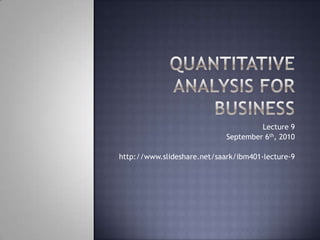
IBM401 Lecture 9
- 1. Quantitative Analysis for Business Lecture 9 September 6th, 2010 http://www.slideshare.net/saark/ibm401-lecture-9
- 2. Example I – 30 to 45 minutes Use 3-period moving average, find the seasonal indices Hint Find Moving Average Sum of seasonal indices must be equal to “n” of each cycle Deseasonalise the data
- 3. Example I
- 4. Example II – 60 minutes Using a 12-period moving average, calculate moving average for the first 2 cycles of the time series in the table. Calculate the adjusted moving average of the first 2 cycles of the time series. Using the calculated moving average and adjusted average, calculate seasonal indices for each month of the first 2 years Assuming a multiplicative model, deseasonalise the time series for the first 2 years. Using regression model Tt = 0.47t + 24.35, forecast year 4 base on multiplicative model, assume no random Calculate the forecast error using mean absolute error (MAE) and mean square error (MSE) of year 4 forecast
- 5. Example ii
- 6. solution
- 7. Example i Moving Average Seasonal Indices
- 8. Example i
- 9. Example i
- 10. Example I – Year 1 deseasonalise
- 11. Example I – year 2 deseasonalise
- 12. Example ii Using a 12-period moving average, calculate moving average for the first 2 cycles of the time series in the table. With even number of periods in the moving-average cycle, we cannot directly relate the moving-average value to a period in the time series. The first moving average needs to be placed midway between June and July to be able to calculate the series’ moving-average
- 13. Example ii
- 14. Example ii – Seasonal indices
- 15. Example ii
- 16. Example ii Using regression model Tt = 0.47t + 24.35, forecast year 4 base on multiplicative model , assume no random F = Tt x St x Ct x Rt
- 17. Example ii Calculate the forecast error using mean absolute error (MAE) and mean square error (MSE) MAE = 63.31/12 = 5.28, MSE = 548.91/12 = 45.74